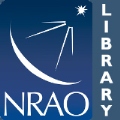NRAO Publication Statistics
NRAO publication statistics are taken from the NRAO publications bibliography (NRAOPapers), a database of refereed and non-refereed papers using NRAO telescope data or with NRAO staff members as authors. NRAOPapers is populated and maintained by the NRAO Library, with new papers added to the database according to our Bibliometrics Policy.
Bibliometrics is the process of measuring productivity and impact for an individual or an institution. For further reading see IAU Commission 5's Best Practices Document and the more recent paper, "Assessing your Observatory’s Impact: Best Practices in Establishing and Maintaining Observatory Bibliographies".
Graph: Refereed NRAO Telescope & Author Papers
The graph, "Refereed NRAO Telescope & Author Papers", shows basic statistics covering the past 10 years.
This graph shows refereed papers by telescope and the total number of refereed papers, including non-NRAO telescope papers with an NRAO author.
Please note the following regarding the Refereed NRAO Telescope and Author Papers Graph:
- Includes papers using archival data from the named telescope.
- Survey papers include: 2001-VCS (VLBA), 2002-VCS (VLBA), 2003-VCS (VLBA), 2005-VCS (VLBA), 2006-VCS (VLBA), 2007-VCS (VLBA), 2008-VCS (VLBA), AEGIS (VLA), ASPECS (ALMA), BeSSeL (VLBA), CHILES (VLA), CORNISH (VLA), CRATES (VLA), FIRST (VLA), GB-20-cm (300-ft), GB-6-cm (300-ft), GB-GB2 (300-ft), GBNCC (GBT), GBT350 (GBT), HRDS (GBT&VLA), JVAS (VLA), LITTLE-THINGS (VLA), MAGPIS (VLA), Maryland-GB (300-ft), MASIV (VLA), MIT-GB-5-GHz (300-ft), MOJAVE-2002 (VLBA), MOJAVE-2004 (VLBA), MOJAVE-I-Sources (VLBA), MOJAVE-II (VLBA), MOJAVE/FERMI (VLBA), MOJAVE/GLAST (VLBA), NVAS (VLA), NVSS (VLA), PRIMOS (GBT), RESUN (VLA), THINGS (VLA), VGPS (GBT&VLA), VIPS (VLBA), VIRMOS (VLA), VIVA (VLA), VLA-ANGST (VLA), VLA-COSMOS (VLA), VLA/VLBA-Pol-Cal (VLA&VLBA), VLBA-2-cm (VLBA), VLBA-Calibrator (VLBA), and VLSS (VLA).
- Other Telescopes include: 12-Meter, 20-Meter, 140-Foot, 300-Foot, 36-Foot, 85-Foot, GB/SRBS, GBI, Interferometer, Radiometer, and VSOP.
- Papers can include multiple telescopes, thus the total number of peer-reviewed telescope papers will be less than the total of all columns.
Graph: Citations by Publication Year for Peer
Reviewed Author and Telescope Papers
The graph, "Citations by Publication Year for Peer Reviewed Author and Telescope Papers", shows bibliometrics gathered from ADS. This database is an excellent source for astronomy publications, but not for engineering or chemistry.
Unfortunately, there is no comprehensive source for citations (whether citation count, H-Index, G-Index or a combination). Some citation sources cover only English-language journals while others cover international ones - but only those that have the largest subscription base. Additionally, some only use refereed sources while others use any source for citation counts, and some providers will not provide any details on what their citation rates entail.
With the understanding that there is no source providing a scientific measure, bibliometrics can be used for comparisons or trends; however, caution is advised.
Please note the following regarding the Citations Graph:
- Citations are a function of time, up to a certain point, so, generally, the older the paper, the more citations the paper will have.
- Includes Refereed Archival data papers.
- Citation counts for NRAO staff-authored papers will never be as high as telescope papers because ADS (source of citation metrics) does not monitor engineering papers to the level astronomy papers are monitored.
- Papers can include multiple telescopes, thus the total number of citations will be less than the total of all columns.




